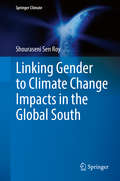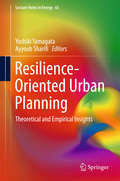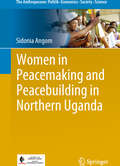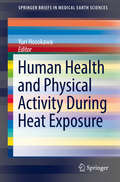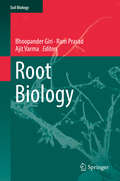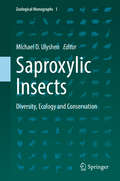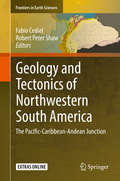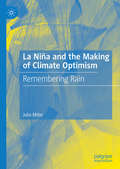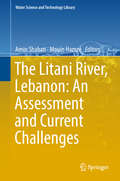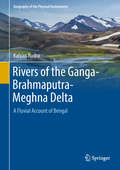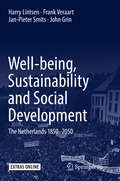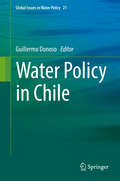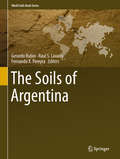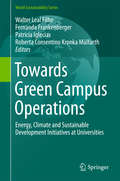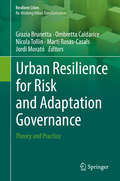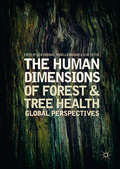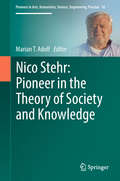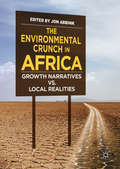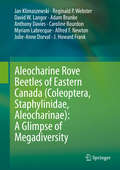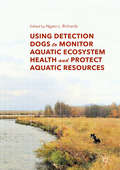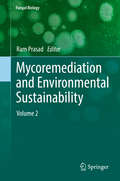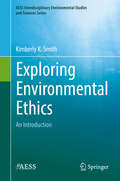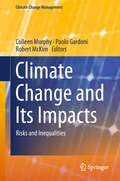- Table View
- List View
Linking Gender to Climate Change Impacts in the Global South (Springer Climate)
by Shouraseni Sen RoyThis authored book assesses the spatial patterns of climate change and gender inequalities across the Global South, and analyzes the disproportionate impacts that climate change processes have on women in these regions. Though many books attempt to incorporate gender issues into climate change, this book examines the issue as a whole by addressing the relationship between climate change and gender from a number of perspectives. The book incorporates case studies from various regions of the Global South, a designation broadly defined as the countries of Africa, Middle and South America, and most of Asia including the Middle East. In the book's two main sections, readers will learn about how climate change affects access to regional opportunities and resources, the obstacles created by climate change that affect women more strongly than men, and how affected female populations adapt to changing conditions and protect their local livelihoods. Section one, covering chapters 1 and 2, addresses the spatial patterns of climate change and gender inequalities/inequities across the Global South by analyzing long-term trends from the latest reports of the Intergovernmental Panel on Climate Change (IPCC) and the World Economic forum. Section two, covering chapters 3 through 7, discusses the critical issues related to climate change and gender inequality, and presents literature reviews and case studies in the Global South. The different issues and perspectives discussed include health, water and food security, education, conflicts, migration, participation in decision-making processes, and changing urban social landscapes. The concluding chapter discusses policy initiatives and makes recommendations to some of the gender mainstreaming through empowerment and participation. This interdisciplinary book will appeal to academics and policy-makers beyond just the fields of environmental sciences and gender studies, and may be adopted as a resource for graduate students and researchers.
Resilience-Oriented Urban Planning: Theoretical and Empirical Insights (Lecture Notes in Energy #65)
by Yoshiki Yamagata Ayyoob SharifiThis book explores key theoretical and empirical issues related to the development and implementation of planning strategies that can provide guidance on the transition to climate-compatible and low-carbon urban development. It especially focuses on integrating resilience thinking into the urban planning process, and explains how such an integration can contribute to reflecting the dynamic properties of cities and coping with the uncertainties inherent in future climate change projections.Some of the main questions addressed are: What are the innovative methods and processes needed to incorporate resilience thinking into urban planning? What are the characteristics of a resilient urban form and what are the challenges associated with integrating them into urban development? Also, how can the resilience of cities be measured and what are the main constituents of an urban resilience assessment framework? In addition to addressing these crucial questions, the book features several case studies from around the world, investigating methodologies, challenges, and opportunities for mainstreaming climate resilience in the theory and practice of urban planning. Featuring contributions by prominent researchers from around the world, the book offers a valuable resource for students, academics and practitioners alike.
Women in Peacemaking and Peacebuilding in Northern Uganda (The Anthropocene: Politik—Economics—Society—Science #22)
by Sidonia AngomThe book analyses the two decades of the brutal civil war of northern Uganda. The author modified Lederach's peacebuilding framework to include peacemaking to bring out the argument that women and men make significant contributions to the peace processes and point out women’s position as top leadership actors. The book uncovers the under-emphasised role of women in peacemaking and building. From grassroots to national level, women were found to have organised themselves and assumed roles as advocates, negotiators and mobilisers. The actions by women became evident at the stalemated Juba peace talks when women presented the Peace Torch to the peace negotiating teams who on the occasion shook hands for the first time and peace was ushered in. Their initiatives and non-violent actions offer lessons to resolve civil conflicts in Africa. The book recommends that women should undergo relevant training in times of peace as this would make them more effective in times of need.
Human Health and Physical Activity During Heat Exposure (SpringerBriefs in Medical Earth Sciences)
by Yuri HosokawaThis book provides fundamental concepts in human thermal physiology and their applications in general public, occupational, military, and athletics settings from the biometeorological perspective. The book includes a section on human physiology, epidemiology and special considerations in aforementioned populations, and behavioral and technological adjustments people may take to combat thermal environmental stress and safeguard their health. The book is the first of its kind to compile multiple disciplines - human physiology, climatology, and medicine - in one to provide fundamental concepts in human thermal physiology and their applications in general public, occupational, military, and athletics settings from the biometeorological perspective;Developed by experts, scientists, and physicians from exercise physiology, climatology, public health, sports medicine, and military medicine;Highlights special considerations and applications of thermal physiology to general public, occupational, military, and athletics settings.
Root Biology: Basic And Applied Concepts (Soil Biology #52)
by Bhoopander Giri Ram Prasad Ajit VarmaThe book ‘Root Biology’ written by experts in the field, covers latest research on cellular, genetic, physiological and ecological developmental facets of root growth as well as the interaction of root with an array of microbes whether for the establishment of symbiosis, increasing plant growth or protecting plant from pathogens/attackers. Plant roots provide an excellent model to study physiological, developmental and metabolic processes at a system level. Root system architecture - an excellent creation of nature, is closely interconnected with the availability of soil nutrients. Several strategies including biotechnological interventions are gaining interest and importance for sustainable food production and enhanced resource acquisition. Such strategies have largely focused on root traits for efficient utilization of soil resources. The biotechnological application of root biology is expected to promote the production of food while maintaining ecologically and economically sustainable production systems.With a fortune of information on technical and experimental aspects useful in the laboratory, this extensive book is a valuable resource for researchers, academician and students in the broad field of microbiology, plant and fungal biology.
Saproxylic Insects: Diversity, Ecology and Conservation (Zoological Monographs #1)
by Michael D. UlyshenThis volume offers extensive information on insect life in dying and dead wood. Written and reviewed by leading experts from around the world, the twenty-five chapters included here provide the most global coverage possible and specifically address less-studied taxa and topics. An overarching goal of this work is to unite literature that has become fragmented along taxonomic and geographic lines. A particular effort was made to recognize the dominant roles that social insects (e.g., termites, ants and passalid beetles) play in saproxylic assemblages in many parts of the world without overlooking the non-social members of these communities.The book is divided into four parts:· Part I “Diversity” includes chapters addressing the major orders of saproxylic insects (Coleoptera, Diptera, Hymenoptera, Hemiptera, Lepidoptera and Blattodea), broadly organized in decreasing order of estimated global saproxylic diversity. In addition to order-level treatments, some chapters in this part discuss groups of particular interest, including pollinators, hymenopteran parasitoids, ants, stag and passalid beetles, and wood-feeding termites.· Part II “Ecology” discusses insect-fungal and insect-insect interactions, nutritional ecology, dispersal, seasonality, and vertical stratification.· Part III “Conservation” focuses on the importance of primary forests for saproxylic insects, offers recommendations for conserving these organisms in managed forests, discusses the relationships between saproxylic insects and fire, and addresses the value of tree hollows and highly-decomposed wood for saproxylic insects. Utilization of non-native wood by saproxylic insects and the suitability of urban environments for these organisms are also covered.· Lastly, Part IV “Methodological Advancements” highlights molecular tools for assessing saproxylic diversity. The book offers an accessible and insightful resource for natural historians of all kinds and will especially appeal to entomologists, ecologists, conservationists and foresters.
Geology and Tectonics of Northwestern South America: The Pacific-Caribbean-Andean Junction (Frontiers in Earth Sciences)
by Robert Peter Shaw Fabio CedielThis book provides a comprehensive overview of the geological evolution of the Northern Andes and contiguous shield areas, with a focus upon Colombia. Updated geological interpretations are supported by modern lithogeochemical, seismic, gravity and magnetic data and radiogenic isotope and radiometric age determinations. The composite data permits a detailed interpretation of the tectono-magmatic history of the Northern Andean Block, including the Andes of Colombia, northern Ecuador, western Venezuela and eastern Panamá.Tectonic reconstructions based upon characterization of more than thirty litho-tectonic and morpho-structural units, terrane assemblages and tectonic realms, and their bounding suture and fault systems, highlight the intimate and complementary Mesozoic-Cenozoic history of the Northern Andean Block and the Pacific and Caribbean Plates.The complex nature of Northern Andean assembly contrasts with ‘‘classical’’ Central Andean ‘‘Cordilleran-type’’ orogenic models. Differences render the application of typical Cordilleran-type models inappropriate for the Colombian Andes.The importance of underlying Proterozoic through mid-Mesozoic elements, in the development of Meso-Cenozoic Northern Andean orogeny-phase tectonic configurations is analyzed in the light of spatial-temporal studies and reconstructions related to basin formation, sedimentation, deformation, uplift mechanisms, structural style and magmatic evolution. The pre-Andean architecture of north western South America has played a pre-determinative role in the development of the Northern Andean orogenic system. 16 contributions analyze key stratigraphic, structural, metamorphic, magmatic and tectonic questions, and provide solutions as far as the most recent published field-based studies permit. The volume provides geological interpretations and tectonic models which contrast with repetitive theoretical proposals frequently found in the available literature.
La Niña and the Making of Climate Optimism: Remembering Rain
by Julia MillerThis book examines the deep connection Australians have with their climate to understand contemporary views on human-induced climate change. It is the first study of the Australian relationship with La Niña and it explains how fundamental this relationship is to the climate change debate both locally and globally. While unease with the Australian environment was a hallmark of early settler relations with a new continent, this book argues that the climate itself quickly became a source of hope and linked to progress. Once observed, weather patterns coalesced into recognizable cycles of wet and dry years and Australians adopted a belief in the certainty of good seasons. It was this optimistic response to climate linked to La Niña that laid the groundwork for this relationship with the Australian environment. This book will appeal to scholars and students of the environmental humanities, history and science as well as anyone concerned about climate change.
The Litani River, Lebanon: An Assessment and Current Challenges (Water Science and Technology Library #85)
by Amin Shaban Mouin HamzéThis book presents a collection of chapters covering research on the Litani River Basin. The Litani River Basin occupies about a quarter of Lebanon's surface area, and it has recently been subject to severe geo-environmental conditions such as water contamination and decreased discharge. This motivated the Lebanese government to take action and start working on the remediation of the river. These actions are also supported by international organizations including the World Bank.
Rivers of the Ganga-Brahmaputra-Meghna Delta: A Fluvial Account of Bengal (Geography of the Physical Environment)
by Kalyan RudraThis is the first comprehensive book on the rivers of the Ganga-Brahmaputra-Meghna delta. This volume covers all aspects of this highly populated region including land conflicts and environmental impacts such as the Indo-Bangladesh conflict over sharing of trans-boundary water. This book addresses the topic from a highly interdisciplinary perspective covering areas of geography, geology, environment, history, archaeology, sociology and politics of the Bengal region.The book appeals to a wide range of audiences from India, Bangladesh and the international community. The style of presentation makes it easily suitable for students, researchers and interested laymen.
Well-being, Sustainability and Social Development: The Netherlands 1850–2050
by John Grin Jan-Pieter Smits Frank Veraart Harry LintsenThis open access book examines more than two centuries of societal development using novel historical and statistical approaches. It applies the well-being monitor developed by Statistics Netherlands that has been endorsed by a significant part of the international, statistical community. It features The Netherlands as a case study, which is an especially interesting example; although it was one of the world’s richest countries around 1850, extreme poverty and inequality were significant problems of well-being at the time. Monitors of 1850, 1910, 1970 and 2015 depict the changes in three dimensions of well-being: the quality of life 'here and now', 'later' and 'elsewhere'. The analysis of two centuries shows the solutions to the extreme poverty problem and the appearance of new sustainability problems, especially in domestic and foreign ecological systems. The study also reveals the importance of natural capital: soil, air, water and subsoil resources, showing their relation with the social structure of the ‘here and now´. Treatment and trade of natural resources also impacted on the quality of life ‘later’ and ‘elsewhere.’ Further, the book illustrates the role of natural capital by dividing the capital into three types of raw materials and concomitant material flows: bio-raw materials, mineral and fossil subsoil resources. Additionally, the analysis of the institutional context identifies the key roles of social groups in well-being development. The book ends with an assessment of the solutions and barriers offered by the historical anchoring of the well-being and sustainability issues. This unique analysis of well-being and sustainability and its institutional analysis appeals to historians, statisticians and policy makers.
Water Policy in Chile (Global Issues in Water Policy #21)
by Guillermo DonosoThis book offers a detailed examination of the main sources of Chile’s water, its principle consumers, the gap between supply and demand, hydrological droughts, and future projected impacts of climate change. It describes, analyzes and evaluates the performance of water policies, laws and institutions, identifies the main challenges that Chile needs to face and derives lessons learnt from Chile’s reform experience.Expert contributors discuss such topics as Chile’s water policy, and the reasoning which explains its policy reform. The book presents and evaluates the performance of the legal and institutional framework of water resources. It also describes efforts to meet actual demands for water by augmenting supplies with groundwater management, waste water re-use and desalination and improve the state of water ecosystems. The last chapter presents the editor’s assessment and conclusions. The case of Chile is illustrative of a transition from command and control to market based management policies, where economic incentives play a significant role in water management.
The Soils of Argentina (World Soils Book Series)
by Gerardo Rubio Raul S. Lavado Fernando X. PereyraThis is the first comprehensive book on Argentinian pedology. It discusses the main soil types of Argentina, their geographical distribution, classification, functions, agricultural use, ecological aspects, and the threats to which they have been subjected during centuries of intensive and extensive management. The description of the soils is accompanied by a complete set of data, pictures and maps, including benchmark profiles and an overview of the country's agricultural production. It also deals with future scenarios of the relationships between soil science and other disciplines and the main challenges that soil science will face in the future. Further, the book explores aspects of the main soil forming factors, such as climate, vegetation, geology and geomorphology, making use of new, unpublished data and elaborations, and presents a history of pedological research in Argentina.
Towards Green Campus Operations: Energy, Climate and Sustainable Development Initiatives at Universities (World Sustainability Series)
by Walter Leal Filho Fernanda Frankenberger Patricia Iglecias Roberta Consentino MülfarthMatters related to sustainable development, albeit global in nature, are best handled at the local level. This line of thinking is particularly true to the higher education context, where the design and implementation of sustainability initiatives on campuses can demonstrate how a given university translates the principles of sustainable development into practice, at the institutional level. Yet, there is a paucity of specific events where a dialogue among sustainability academics and practitioners concerned with a) research, projects b) teaching and c) planning and infra-structure leading to campus greening takes place, so as to allow a transdisciplinary and cross-sectoral exchange of ideas and experiences on the issues, matters and problems at hand. It is against this background that this book has been prepared. It is one of the outcomes of the “First Symposium on Sustainability in University Campuses” (SSUC-2017) organised by the University of São Paulo in Brazil, Manchester Metropolitan University (UK), the Research and Transfer Centre “Applications of Life Sciences” of the Hamburg University of Applied Sciences (Germany), and the Inter-University Sustainable Development Research Programme (IUSDRP). This book showcases examples of campus-based research and teaching projects, regenerative campus design, low-carbon and zero carbon buildings, waste prevention, and resilient transport, among others. It also demonstrates the role of campuses as platforms for transformative social learning and research, and explores the means via which university campuses can be made more sustainable. The aims of this publication are as follows: i. to provide universities with an opportunity to obtain information on campus greening and sustainable campus development initiatives from round the world; ii. to document and promote information, ideas and experiences acquired in the execution of research, teaching and projects on campus greening and design, especially successful initiatives and good practice; iii. to introduce methodological approaches and projects which aim to integrate the topic of sustainable development in campus design and operations. This book entails contributions from researchers and practitioners in the field of campus greening and sustainable development in the widest sense, from business and economics, to arts, administration and environment.
Urban Resilience for Risk and Adaptation Governance: Theory and Practice (Resilient Cities)
by Grazia Brunetta Ombretta Caldarice Nicola Tollin Marti Rosas-Casals Jordi MoratóThis book brings together a series of theory and practice essays on risk management and adaptation in urban contexts within a resilient and multidimensional perspective. The book proposes a transversal approach with regard to the role of spatial planning in promoting and fostering risk management as well as institutions’ challenges for governing risk, particularly in relation to new forms of multi-level governance that may include stakeholders and citizen engagement. The different contributions focus on approaches, policies, and practices able to contrast risks in urban systems generating social inclusion, equity and participation through bottom-up governance forms and co-evolution principles. Case studies focus on lessons learned, as well as the potential and means for their replication and upscaling, also through capacity building and knowledge transfer. Among many other topics, the book explores difficulties encountered in, and creative solutions found, community and local experiences and capacities, organizational processes and integrative institutional, technical approaches to risk issue in cities.
The Human Dimensions of Forest and Tree Health: Global Perspectives
by Clive Potter Julie Urquhart Mariella MarzanoThis book explores the specifically human dimensions of the problem posed by a new generation of invasive pests and pathogens to tree health worldwide. The growth in global trade and transportation in recent decades, along with climate change, is allowing invasive pests and pathogens to establish in new environments, with profound consequences for the ecosystem services provided by trees and forests, and impacts on human wellbeing. The central theme of the book is to consider the role that social science can play in better understanding the social, economic and environmental impacts of such tree disease and pest outbreaks. Contributions include explorations of how pest outbreaks are socially constructed, drawing on the historical, cultural, social and situated contexts of outbreaks; the governance and economics of tree health for informing policy and decision-making; stakeholder engagement and communication tools; along with more philosophical approaches that draw on environmental ethics to consider ‘non-human’ perspectives. Taken together the book makes theoretical, methodological and applied contributions to our understanding of this important subject area and encourages researchers from across the social sciences and humanities to bring their own disciplinary perspectives and expertise to address the complexity that is the human dimensions of forest and tree health.Chapters 5 and 11 are open access under a CC BY 4.0 license via link.springer.com.
The Human Dimensions of Forest and Tree Health: Global Perspectives
by Clive Potter Julie Urquhart Mariella MarzanoThis book explores the specifically human dimensions of the problem posed by a new generation of invasive pests and pathogens to tree health worldwide. The growth in global trade and transportation in recent decades, along with climate change, is allowing invasive pests and pathogens to establish in new environments, with profound consequences for the ecosystem services provided by trees and forests, and impacts on human wellbeing. The central theme of the book is to consider the role that social science can play in better understanding the social, economic and environmental impacts of such tree disease and pest outbreaks. Contributions include explorations of how pest outbreaks are socially constructed, drawing on the historical, cultural, social and situated contexts of outbreaks; the governance and economics of tree health for informing policy and decision-making; stakeholder engagement and communication tools; along with more philosophical approaches that draw on environmental ethics to consider ‘non-human’ perspectives. Taken together the book makes theoretical, methodological and applied contributions to our understanding of this important subject area and encourages researchers from across the social sciences and humanities to bring their own disciplinary perspectives and expertise to address the complexity that is the human dimensions of forest and tree health.Chapters 5 and 11 are open access under a CC BY 4.0 license via link.springer.com.
Nico Stehr: Pioneer in the Theory of Society and Knowledge (Pioneers in Arts, Humanities, Science, Engineering, Practice #16)
by Marian T. AdolfThis unique volume brings together a selection of the most important texts of Nico Stehr for the first time and puts them in dialogue with original research that draws on his prolific work. Covering five decades of pioneering sociological research on the theory of society and knowledge, the book introduces the reader to Stehr’s seminal inquiries into the economic, political and social role of knowledge. Original concepts, such as his groundbreaking studies on the Knowledge Society, are introduced as the volume traces Stehr’s pursuit of social scientific research as a source of practical knowledge for modern society.The book comprises three parts devoted to the many facets and the remarkable range of Nico Stehr’s oeuvre. Part 1 provides an introduction to the significance of his pioneering work and career. Part 2 demonstrates the practical application of Nico Stehr’s research as seen through the eyes of eminent scholars. Part 3 presents a selection of the milestones of his publications.
The Environmental Crunch in Africa
by Jon AbbinkThis book discusses the problems and challenges of environmental–ecological conditions in Africa, amidst the current craze of economic growth and ‘development’. Africa’s significant economic dynamics and growth trajectories are marked by neglect of the environment, reinforcing ecological crises. Unless environmental–ecological and population growth problems are addressed as an integral part of developmental strategies and growth models, the crises will accelerate and lead to huge costs in later years. Chapters examine multiple emerging tension points all across the continent, including the potential benefits and harm of growing urban-based ecotourism, the trajectory of labour-saving technologies and the problems facing agro-pastoralism. Although environmental management and sustainability features of African rural societies should not be idealized, functional 'traditional' economies, interests and management practices are often bypassed, seen by state elites as inefficient and inhibiting 'growth'. In many regions the seeds are now sown for lasting environmental crises that will affect local societies that have rarely been given opportunity to claim accountability from the state regimes and donors driving these changes.
Aleocharine Rove Beetles of Eastern Canada (Coleoptera, Staphylinidae, Aleocharinae): A Glimpse of Megadiversity
by Jan Klimaszewski Reginald P. Webster David W. Langor Adam Brunke Anthony Davies Caroline Bourdon Myriam Labrecque Alfred F. Newton Julie-Anne Dorval J. Howard FrankA first comprehensive synopsis of all aleocharine rove beetle species (Coleoptera, Staphylinidae) recorded from eastern Canada, from Ontario to the Maritime Provinces inclusively, is presented. Four hundred and seven species in 96 genera, and 16 tribes are presented and discussed.Tribes and subtribes are arranged in presumably phylogenetic order as it is currently recognized. Genera and subgenera are listed alphabetically. Species are listed alphabetically or in species groups to better reflect their relationships. Species distribution is listed by abbreviated provinces and territories in Canada and abbreviated states in the United States. Geographic status is given to every species as Native, Holarctic or adventive with some species listed with undetermined status - adventive or Holarctic. Every treated species is presented with a diagnosis, including short description of body and description of the median lobe of aedeagus, spermatheca, and tergite and sternite VIII of both sexes. For each species a plate with colour habitus image and black and white images of genital structures is provided to aid with positive identification. Collection and habitat data (often new) are presented for each species, including data on macrohabitat, microhabitat, collecting period, and collecting methods.
Using Detection Dogs to Monitor Aquatic Ecosystem Health and Protect Aquatic Resources
by Ngaio L. RichardsThis book is about the varied range of emerging applications using specially trained detection dogs to monitor and protect aquatic ecosystems, animals, plants and related resources. Featuring contributions from those at the forefront of converging disciplines ranging from canine training, ecological and biological monitoring, water resource management, law enforcement, and eco-toxicology, it addresses everyone already immersed in these or related fields, and anyone seeking to gain a broader understanding of them. Chapters cover several common themes including monitoring presence/absence through biological and ecological surveys; maintaining and evaluating water quality; law enforcement and anti-poaching initiatives; public education, awareness and compliance; standards and best practices; optimal uses of dogs in relation to and in conjunction with other available tools and pragmatic considerations for selecting and working with dogs and handlers. The aim of the book is to stimulate new ideas, promote the sharing and dissemination of information and findings - and, ideally, to catalyze new and innovative partnerships, to strengthen the preservation and conservation of our aquatic heritage.
Using Detection Dogs to Monitor Aquatic Ecosystem Health and Protect Aquatic Resources
by Ngaio L. RichardsThis book is about the varied range of emerging applications using specially trained detection dogs to monitor and protect aquatic ecosystems, animals, plants and related resources. Featuring contributions from those at the forefront of converging disciplines ranging from canine training, ecological and biological monitoring, water resource management, law enforcement, and eco-toxicology, it addresses everyone already immersed in these or related fields, and anyone seeking to gain a broader understanding of them. Chapters cover several common themes including monitoring presence/absence through biological and ecological surveys; maintaining and evaluating water quality; law enforcement and anti-poaching initiatives; public education, awareness and compliance; standards and best practices; optimal uses of dogs in relation to and in conjunction with other available tools and pragmatic considerations for selecting and working with dogs and handlers. The aim of the book is to stimulate new ideas, promote the sharing and dissemination of information and findings - and, ideally, to catalyze new and innovative partnerships, to strengthen the preservation and conservation of our aquatic heritage.
Mycoremediation and Environmental Sustainability: Volume 2 (Fungal Biology)
by Ram PrasadBioremediation is the use of microorganisms' metabolism to degrade waste contaminants (sewage, domestic, and industrial effluents) into non-toxic or less toxic materials by natural biological processes. Volume 2 offers new discussion of remediation through fungi—or mycoremediation—and its multifarious possibilities in applied remediation engineering and the future of environmental sustainability. Fungi have the biochemical and ecological capability to degrade environmental organic chemicals and to decrease the risk associated with metals, semi-metals, noble metals, and radionuclides, either by chemical modification or by manipulating chemical bioavailability. Additional expanded texts shows the capability of these fungi to form extended mycelia networks, the low specificity of their catabolic enzymes, and their use against pollutants as a growth substrate, making these fungi well suited for bioremediation processes. Their mycelia exhibit the robustness of adapting to highly limiting environmental conditions often experienced in the presence of persistent pollutants, which makes them more useful compared to other microbes. Despite dominating the living biomass in soil and being abundant in aquatic ecosystems, however, fungi have not been exploited for the bioremediation of such environments until this added Volume 2. This book covers the various types of fungi and associated fungal processes used to clean up waste and wastewaters in contaminated environments and discusses future potential applications.
Exploring Environmental Ethics: An Introduction (AESS Interdisciplinary Environmental Studies and Sciences Series)
by Kimberly K. SmithThis book is designed as a basic text for courses that are part of an interdisciplinary program in environmental studies. The intended reader is anyone who expects environmental stewardship to be an important part of his or her life, as a citizen, a policy maker, or an environmental management professional. In addition to discussing major issues in environmental ethics, it invites readers to think about how an ethicist's perspective differs from the perspectives encountered in other environmental studies courses. Additional topics covered include corporate social responsibility, ecological citizenship, property theory, and the concept of stewardship as a vocation.
Climate Change and Its Impacts: Risks and Inequalities (Climate Change Management)
by Colleen Murphy Paolo Gardoni Robert McKimResponding to a need for a deeper and more nuanced understanding of the consequences of climate change, this book brings experts in climate science, engineering, urban planning, and conservation biology into conversation with scholars in law, geography, anthropology and ethics. It provides insights into how climate change is conceptualized in different fields. The book also aims to contribute to developing successful and multifaceted strategies that promote global, intergenerational and environmental justice. Among the topics addressed are the effects of climate change on the likelihood and magnitude of natural hazards, an assessment of civil infrastructure vulnerabilities, resilience assessment for coastal communities, an ethical framework to evaluate behavior that contributes to climate change, as well as policies and cultural shifts that might help humanity to respond adequately to climate change.
